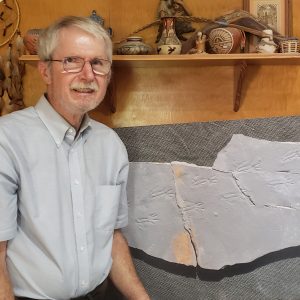
Dr. Ron Buta, professor emeritus of Astronomy, has been a major force in avocational or amateur paleontology since he rediscovered his interest in paleontology in mid-1990s. For his substantial contributions uncovering the prehistory of Alabama, he has been selected as the 2021 recipient of the prestigious Alabama Avocational Paleontologist Award. The award will be presented during the annual celebration of National Fossil Day in the Alabama Museum of Natural History in Tuscaloosa on Wednesday October 13, from 5:00-7:00 pm.
“Ron Buta is particularly well-known in and outside Alabama for the books and scientific articles he wrote with colleagues about coal-age fossils found in northern Alabama,” Dr. Adiel Klompmaker, UA Museums’ Curator of Paleontology and a member of the award committee, said. Those ~315 million years old coal-age rocks contain many trackways of ancient amphibians, primitive reptiles, and invertebrates as well as various amazing plant fossils.
Ron amassed a large collection of fossil footprints and plants from the Crescent Valley Mine since 2011, but he also found many fossils at the famous Union Chapel Mine. “Over the last decade, he has graciously donated several thousands of fossils found in these open-pit mines in Walker County to the Alabama Museum of Natural History fossil collection and other collections,” Klompmaker mentioned. Ron also played a role in saving the Union Chapel Mine (Steven C. Minkin Paleozoic Footprint Site) as a fossil site and he has been active in outreach events. The committee concluded that Ron Buta is a very worthy of receiving the award.
“I was very delighted to hear this,” Ron said in a first reaction. “What an honor! The motivation to do good work does not necessarily depend on the possibility of receiving an award, but it means a lot to have one’s work so recognized.”
Discovering glimpses of past life is highly exciting to Ron: “I have most enjoyed the moments when, after splitting a rock, I was startled by the presence of a preserved trackway in the slab. It is a thrilling experience because when this happens, you become the first person ever to have seen the tracks exposed.”
Ron is particularly proud of his research at the Crescent Valley Mine, a mine very close to where Alabama trackways were first reported from in 1930. His photo database involves as many as 15,000 digital images covering nearly 5,000 specimens.

“Another thing I have enjoyed is what an amazing place Alabama is for paleontology,” Ron said. “I think none of the neighboring states has the richness of diversity that is found in Alabama fossils. This is especially true for Alabama trace fossils [such as trackways].”
The Alabama Avocational Paleontologist Award (ALAP award) was created in 2020 to honor individuals who have made outstanding contributions to Alabama paleontology. “There are dozens of very active avocational paleontologists scouring Alabama’s surface for fossils and they play a very important role in Alabama paleontology,” Klompmaker said. “Think of people finding fossils and making them available for study, volunteers at museums, people doing outreach activities, and folks writing papers and books about fossils.” Most of them are either a member of the Alabama Paleontological Society or the Birmingham Paleontological Society, both of which organize field trips and have regular meetings during normal times.
The ALAP award presentation is scheduled for 6:30 pm in the Alabama Museum of Natural History on Wednesday October 13. Other activities include science tables with many fossils from 5:00-7:00 pm and a keynote talk by Dr. Takehito Ikejiri (Ike) from 6:00-6:30 about extinctions of marine vertebrates in Alabama during the Cretaceous.